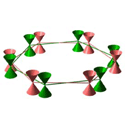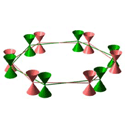Graphene with a twist
Stacks of graphene are expected to possess drastically different electronic properties compared to their single-layer components, as a result of interlayer coupling. Theory dictates that graphene’s massless low-energy excitations should disappear, even for the simple bilayer structure. However, experiments have shown that, paradoxically, the electronic properties of single layers somehow survive in layered structures. Theorists have suggested that a relative rotation of one layer with respect to the one below it—a “twist” in the stacking—might be the resolution of the paradox.
Now, in a paper appearing in Physical Review Letters, Adina Luican and collaborators from Rutgers University and the Massachusetts Institute of Technology, both in the US, and the University of Manchester, UK, provide experimental proof of the influence of twisting on the band structure of bilayer graphene. Using scanning tunneling microscopy and spectroscopy, the researchers find that for twist angles above 20°, the electronic properties of the twisted layers are practically indistinguishable from those of single-layer graphene. Based on their measurements, Luican et al. conclude that at small angles, the massless Dirac fermion picture of graphene breaks down and the electronic spectrum is dominated by a saddle point feature, while at large rotation angles, the intersection point in the spectrum shifts to irrelevant high energies and the familiar Dirac energy dispersion is recovered. – Alexios Klironomos





